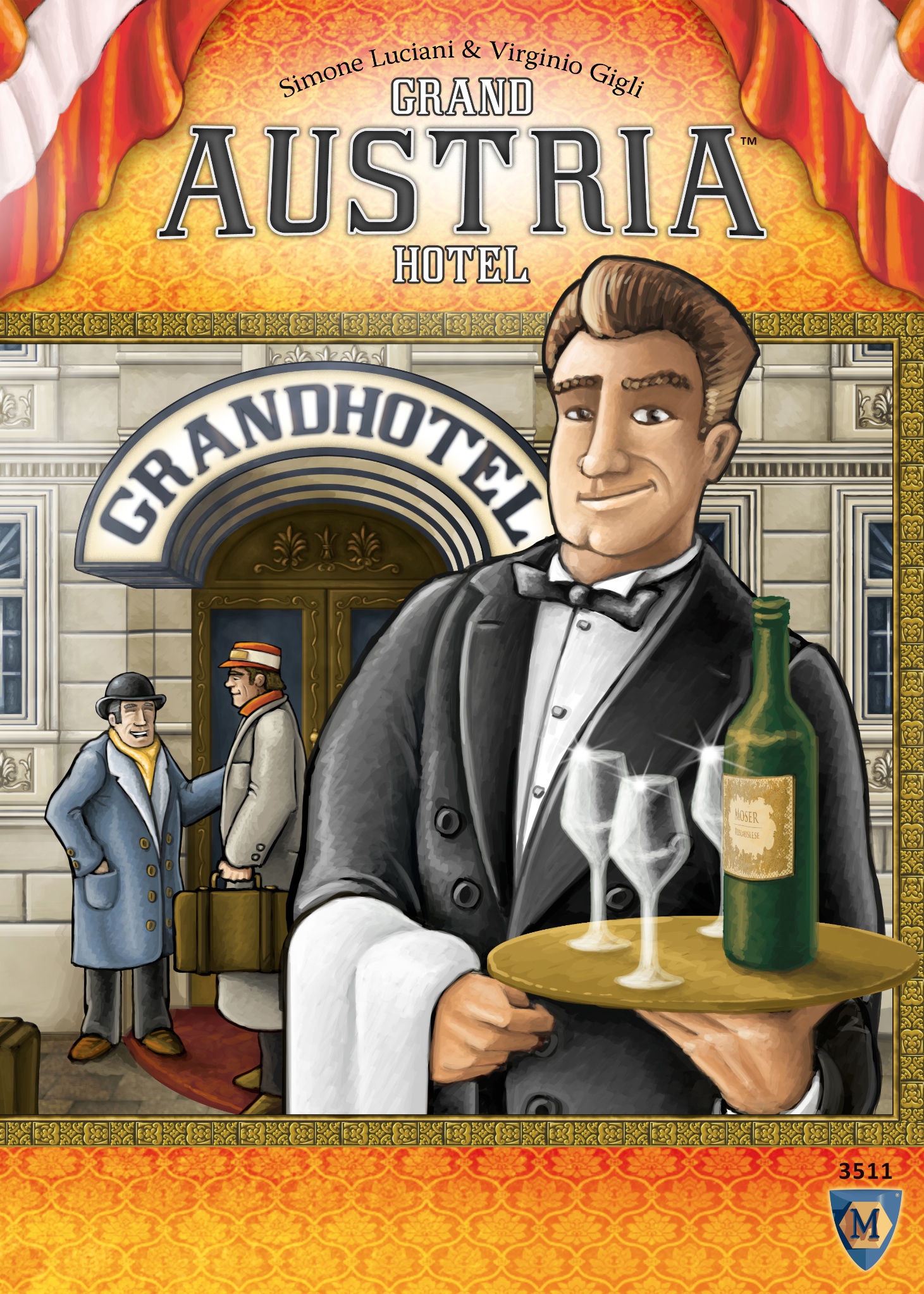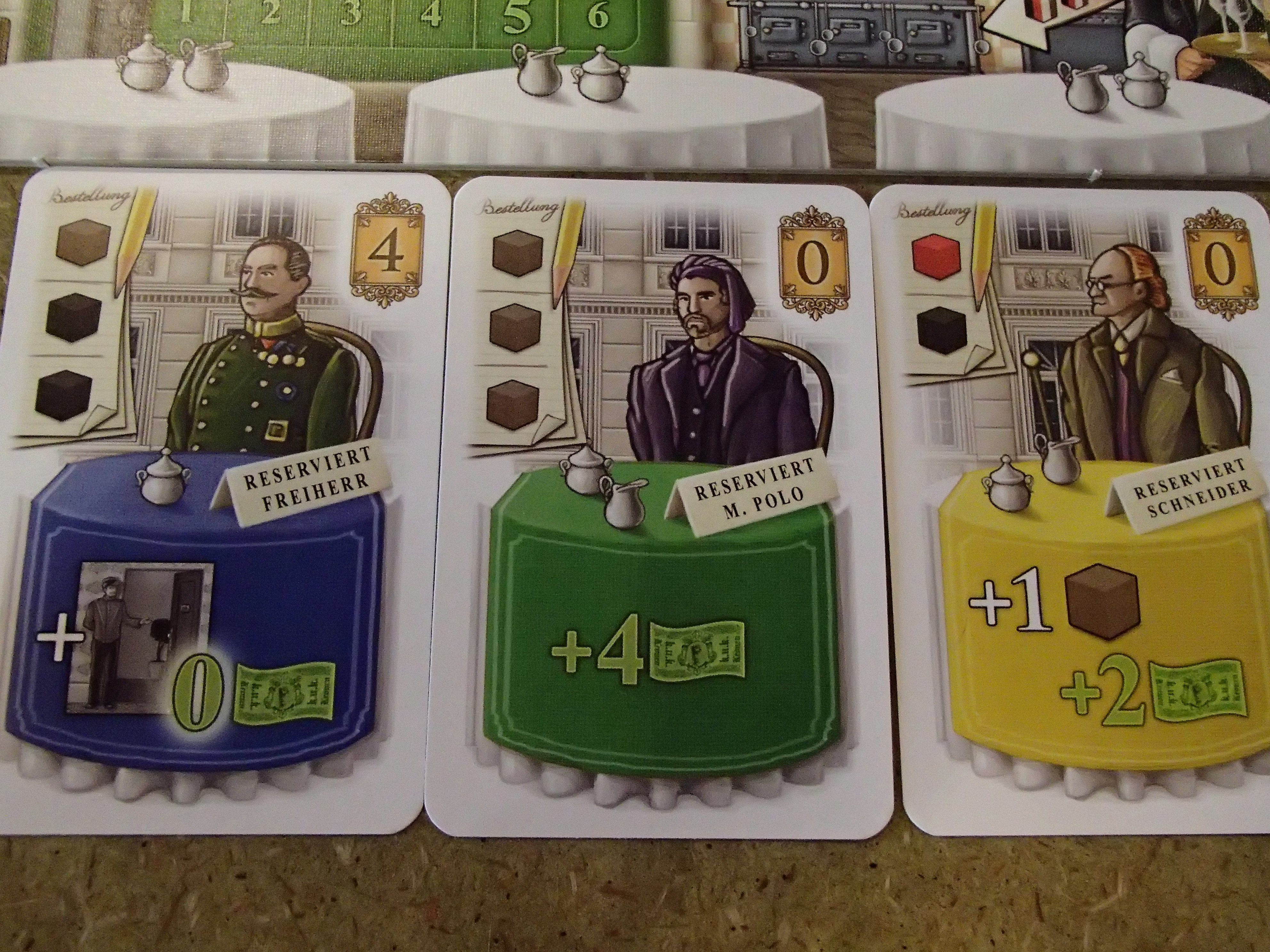| Publisher | Mayfair Games |
| Design Credits | Simone Luciani, Virginio Gigli |
| Art Credit | Klemens Franz |
| Translation Credit | Grzegorz Kobiela |
| Game Contents | Action board, game board, four two-sided player hotel boards, 56 Guest cards, 48 Staff cards, 12 Politics cards, four Overview player aid cards, nine Turn Order tiles, 84 Room tiles in three colors, 12 Emperor tiles, one dustbin tile, 120 wooden cubes in four colors, 14 six-sided dice, 24 wooden disks in four player colors, four Victory Point markers, one wooden Round marker, rules |
| Guidelines | Viennese hospitality and business game |
| MSRP | $60 |
| Reviewer | Andy Vetromile |
If you want to fill rooms in your hotel, you go – or rather build – where the action is. In the 1920s that meant taking advantage of the hustle and bustle of Vienna, then a vibrant place for art, culture, and development. Not every such institution can be the Grand Austria Hotel, but whoever makes theirs the crown jewel of the Empire’s hospitality set is going to win the Emperor’s favor in Mayfair’s new game.
The object is to amass the most Victory Points.
Two to four hoteliers vie to operate the best inn in Austria. Like any good outlet they have a café to service the guests, who then proceed to their lodgings for the night. Guest cards are drafted from a track, varying in cost and appetite. As some are chosen the remainder slide down the track to the cheaper positions and new guests appear at the back of the queue. These visitors sit down at the Café and await their order – each wants some arrangement of food and drink represented by colored cubes. If a player fulfills their wishes, the patron is ready to retire for the evening and needs a suite of the appropriate color. Blue guests want blue rooms, for example, though the green guests are tourists who take whatever you offer them.
Above the Café are four floors of rooms, many put together in “blocs” of one color. One cannot accommodate a guest until his room is prepared, so one puts little counters of the matching color on a space to show a room is ready there. One side shows hotel staff motioning guests inside while the opposite shows a doorknob with a “Do not disturb” placard. Rooms on higher floors are more expensive to ready but score more points. They cannot be prepared “shotgun” style, though, the tiles must be placed orthogonally: One essentially “builds” them like bricks in a wall, up or across, connected to previous placements. When a guest enters his space, that tile flips and the Guest card provides his listed benefit to his host – bonus VPs or money, perhaps, or a discount on hiring new staff.
One accomplishes all of this and more by taking dice from the Action board. Every round starts with rolling the dice and arranging them by number – all the 1s in the first Action space and so on. On a player’s turn he takes one die and the associated action. This may be food and drink cubes, room preparation, money, advancement on the Emperor track, or new staff. The sixth is a “wild card” costing a dollar to use but it duplicates the other columns if one runs low on dice. The more dice in an Action space when one selects it, the greater the benefit: added cubes or rooms, a higher discount on hiring staff, and so on.
Three of the seven rounds of play score on the Emperor track; not only is advancing further on it worth more points it may generate other bonuses (randomized for each game). The trick here is every player loses an increasing number of spaces as the game progresses, and if one falls far enough he not only misses the bonus he may incur a penalty. There are also Politics cards, randomized as the Emperor tile bonuses each game, that are worth points for reaching certain milestones like a specific amount of money or a number of staff hires. After seven rounds the hotelier with the highest Victory Point total wins.
The grandest part of Grand Austria Hotel may be the production values, because this is one expansive and pretty game, but they’re undercut by also featuring the game’s biggest weaknesses. The colors are bright, the graphics are large, the Hotel boards are double-sided for expert play, and most of the symbols are obvious. Less evident is how the symbols work together to avoid language dependency. There’s the usual assortment of arrows and images representing flips and placements and rewards but these don’t always come across clearly. A dashed line before money may indicate a penalty of lost funds, a discount on new hires or room prep, or simply payment for services listed on the player-aid Overview cards. A zero means a free play but since it’s not simply crossed off like other resource symbols one might think it indicates “no change to the price.” Sometimes a 1 is used to indicate one staff is played, other times no 1 is included.
The player markers fit the Victory Point track up until the corner spaces. These split in two along the diagonal (a la the “21/22” spaces, for example), where pawn placement becomes crowded and awkward. Having a money track on the Hotel boards instead of chits saves costs and space, but jostling it can wipe out one’s fortune. The rules are thorough but not without oversights: A picture of an occupied room is referred to in accompanying text as unoccupied (the sort of thing one never wants since it adds a little uncertainty to the overall work). Text is small – the Staff card script and Guest card printing are painfully tiny, though there are hidden, humorous nods within. The rules are silent on whether one can earn krones beyond the printed 20-point limit. The writing even takes a gratuitous, un-P.C. shot at the Scottish. And the (black) coffee and (brown) strudel cube colors are a little too close together on the color wheel.
The Grand Austria Hotel was a busy place, and now it has a pretty busy game to go with it. It’s not a drag to keep track of all the elements that go into a successful play, but it is a thinker of a game, the kind that claims 90 minutes when you know darn well it’s going to be the only game you have time to get to that evening. Though it’s true there are many avenues to travel in pursuit of the win, you have to include more things than you omit when working toward your goal – leave too many out and you simply won’t have the points to prevail.
While resources get scarce they never really become tight; even if you lack for something there’s no secret to getting it back. Making all the moving parts work in your favor takes a few plays, and it’s the way these fragments go from disparate pieces to cogs in a conveyor belt that burns the brain and satisfies the mind the most. Benefits come from many sides – satisfied guests, hired staff, Emperor tiles, even bonuses for finishing “blocs” of like-colored rooms – but stringing them together takes insight, like trying to come up with a productive mathematical expression. Those good with pattern recognition do well, those without may become a bit frustrated, but even with VPs trying to pour in through every crack in the door the rules do what they can to ensure no one strategy permits a windfall. Everything is on equal footing at the Grand Austria Hotel – the staff wouldn’t have it any other way.



